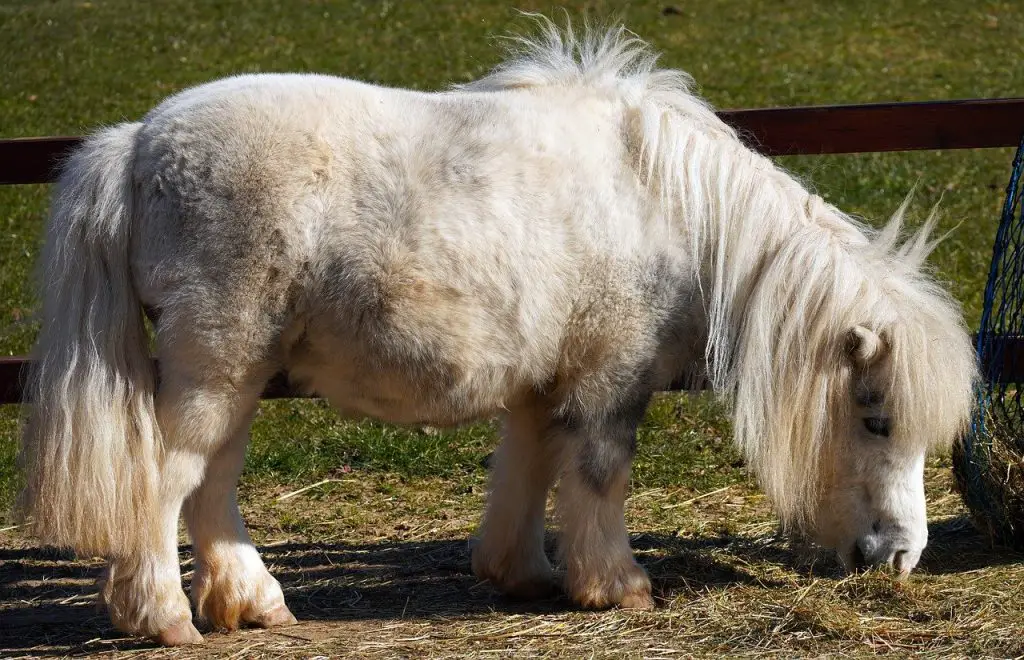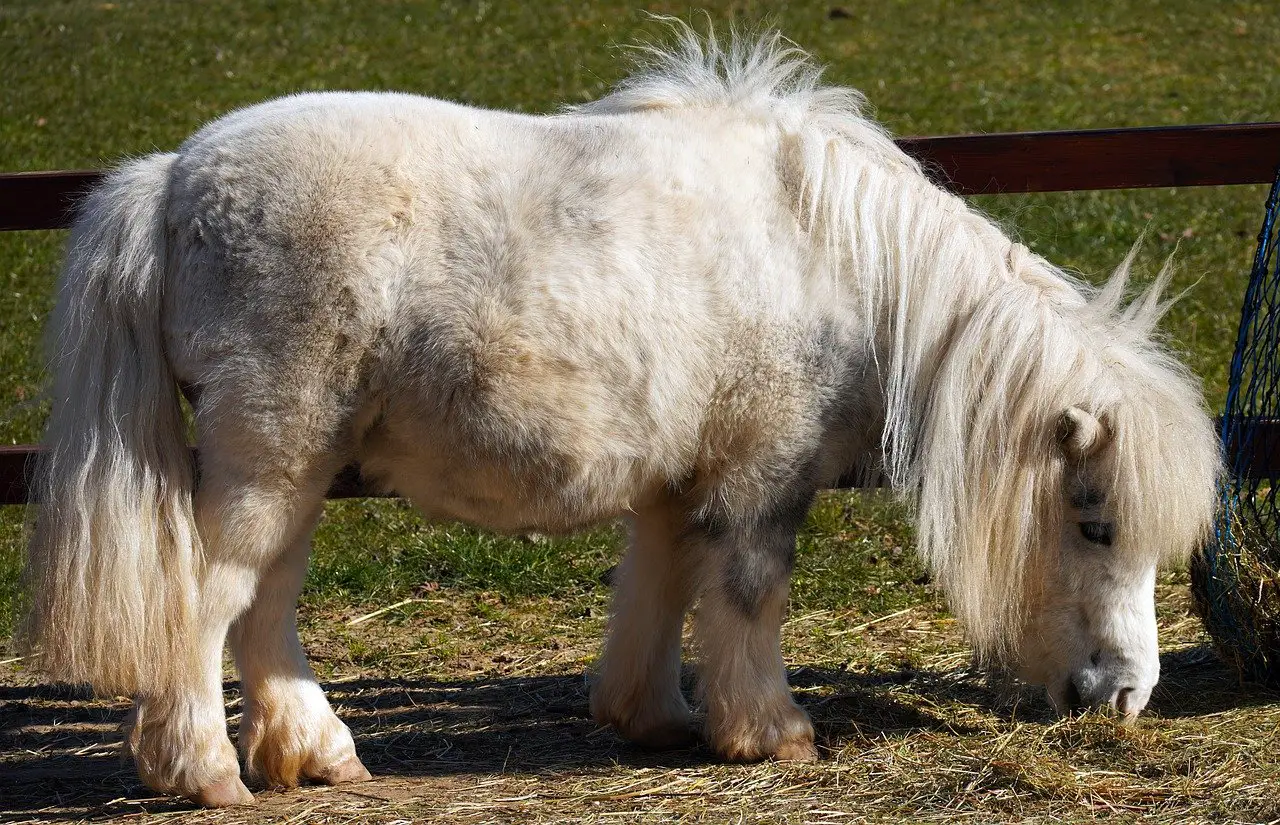Last Updated on March 11, 2022 by Allison Price
About the Breed
The Evolution of the Breed One of Shetland’s earliest laws warned would-be thieves to not “cut any man’s horse-tail (sic)” under the threat of ten pounds. This reflects the severity of the crime as well as the Shetland dependency on fishing and their ponies for their lives. Ponies from Shetland provided the raw materials needed to make fishing nets and lines. Fishing was the main source of income for many islanders. An old Shetland proverb says that an Orkney man must fish, while a Shetland one must farm. The Shetland pony bridged this gap between these two ways of life.
The history of Shetland ponies is better documented than other breeds. It reads almost like the history on the islands. Two thousand years ago, a pony similar to the Shetland pony lived on the islands. The pony was a mix of Viking and British to make a distinctive Shetland type, much like the islanders. It was most likely a hybrid breed. It contained the blood of the British Hill pony, such as a Highland or Fell/Dale from Scotland, and a Scandinavian-influenced breed with some Oriental bloodlines. A ninth-century stone carving on Bressay depicts the pony that resulted. The image depicts a priest riding a small pony.

Researchers concluded that Shetland’s pony was domesticated long ago based on this evidence and other archaeological findings. It is not clear how it got to the islands. Everyone loves a good story. Some believe that ponies were among the first settlers to the islands. It could also be that ponies were lost at sea from the Gran Grifton, the Spanish Armada flagship that sank off Fair Isle’s coast, as a result of shipwrecks. Maybe Crusaders who returned from Constantinople and Jerusalem brought Arabian stock to the islands. Or Viking marauders from Iceland left their mark in the white markings of Shetland ponies. We don’t know for sure.
Island Conditions
The relative isolation of the islands is key to understanding how such a varied stock background could result in such a resilient and constant breed. The ponies had to live with a hostile environment, despite their romanticism. The ponies had to live on poor grass, hard, damp ground, and under the constant blowing wind. They were forced to conserve heat due to the cold environment. The result was a pony with short legs, thick ears, a narrow back and thick neck. The big stock was starved and the fragile stock died; only small, fast, tough, intelligent animals survived.
According to the first stud book, Shetland ponies were ‘foaled in fields, live in fields, and die in fields’. They can still be seen on their native islands today. The Shetland pony’s survival insurance is the flowing tail and thick furry winter coat. Because the hills are very steep and uneven, and sometimes steep, it is not unusual for Shetland pony to have a flowing gait and sure-footedness that covers miles every day on poor grazing.
The Scattald
Common grazing or scattald has been used for hundreds of years by crofters as a supplement to their small acreage of arable land ‘in-by.’ Although these acres of heather-clad moorland may seem like a scarce habitat for animals, the Shetland pony (and Shetland sheep) have developed high conversion rates and a relatively high milk yield to nurse their offspring. Because of the hilly terrain, shelter is possible from all wind directions, whether behind a hillock or an old stone wall. Many crofters have recently enclosed their shares in the common grazings using wire fencing, which has dramatically reduced the animals’ ability to find shelter or range.
Many scattalds have beach access, so both ponies as well as sheep can enjoy seaweed at low tide. This will supplement their regular diet and increase their intake of minerals.
Most crofters keep their ponies in-by during winter. They then put them on the scattald in May and foaling to run with a horse until September. Each mare is confined to her own hill, and the stallion tends to group them together and bring them along. A premium stallion program has been established by the Shetland Pony Stud Book Society, the Department of Agriculture and other organizations. This scheme allows for the selection of good stallions and their placement on different scattalds in the summer months.
The Croft
Most crofters didn’t ride their ponies. Some accounts mention ponies being used by ministers or doctors to visit their communities, but most ponies lived on the cattalds. The scattald was the only place where ponies could be found until they were needed to “flitting through the peats.” They carried freshly cut peats up the hills to their homes, where they would use them as fuel. The ponies had to travel cross-country because there were very few roads. They carried heavy, woven saddlebags, called “kishies”, that were hung from wooden “klibbers” on their backs.
For most of their history, shetlands were pack and saddle animals. Only after roads were made, were horses used for draft purposes. Until the Mines Act of 1847, Shetlands were only used for draft purposes.
Ponies in Mines
Children were prohibited from working in heavy underground mines in Britain by the Mines Act of 1847. The Shetland’s petite stature made them very valuable, and hundreds of geldings were sold south. At the age of four, they entered the mines. Years later, they retired to a life of pasture and retirement. Although there were many types of ponies that worked in the mining industry the Shetlands were the most important because they could only travel through the narrowest shafts.
Imagine underground, tens to thousands of ponies and young men. The men would eventually return to their families at the surface, but the ponies were kept underground with the exception of one year. According to accounts, the ponies were well cared for in mines that had good worker/managerial relationships. Poorer worker relations and abuse in mines often resulted in poorer conditions for ponies.
Some mines had men draw lots to decide who would work with which pony. The men would stay with the pony for a certain number of months, grooming and hauling alongside each other. There was a real love between the horses and the men. There are many stories of horses bolting or balking their way out of cave-ins. Their lives were so closely linked that it was obvious that their loyalty was deep within the pits.
The Shetlanders almost lost control over their stock during this period as many of the finest stallions were shipped to the mines. John and James Ingram, in the Statistical Account of Shetland 1841, noted that “the ponies now have a smaller size than thirty years ago” and that large profits could be made by selling stallions for mining work. Many farmers living at subsistence level could not afford to keep their best stock to breed.
Major landowners were exempted from this rule. Londonderry Stud was established by Lord Londonderry in 1870. It used the nearby islands of Bressay, Noss, and the existing stock from local crofters. Bressay crofters used Lord Londonderry’s Stallions to raise their mares from his Noss facilities. The owner of the stallion would purchase the foal and then export it to the mines. If the foal were a filly it would be kept for breeding stock or exported to America, where there was high demand from stud farms.
Even though ponies were no longer in great numbers in the mines after mechanization, they continued to work there in a limited number. Ponies were still found underground in Britain up until the 1970s.
The boom in Shetland pony trade lasted until the First World War. Upper class children in Britain coveted Shetlands. While Queen Elizabeth and her siblings loved ponies as children, driving Shetlands for wealthy people was a popular pastime for many decades. The market for Shetlands plummeted in the 1930’s and 1940’s. The Shetlands were replaced by Welsh ponies for entertainment and the internal combustion engine for transport. Mares and fillies that were born on the islands weren’t available for sale because shipping to Aberdeen cost more than the total value of the animals.
Shetland Ponies Today
The Shetland Pony is often mentioned in the media today. They make great children’s first ponies if they are properly broken. The Shetland Pony Stud Book Society Award Schemes for Ridden and Driven Ponies have resulted in the Shetland Pony now competing against all other large hairy native breeds in show ring. The Shetland Pony participates in the Shetland Pony National at the International Horse Show in Olympia in December. It also scurries at the Horse of the Year Show in Wembley, October. There are hundreds of other shows across Great Britain. Proud owners often show off their Shetland ponies and they often win against anyone else.
Shetland ponies, who are at home on their islands, can still be seen grazing along the roadsides or on the heathery hills, with their photogenic foals at their feet delighting tourists and photographers — looking wild, but all owned by proud local crofters.
Breed Characteristics
You can see the Shetland pony in any color except spotted: black, chestnut or grey. The Shetland pony’s height is measured at the withers, unlike larger horses that are measured in hands. The Shetland pony is the smallest British native breed. Its maximum height is 42 inches, with a minimum of 28 inches.
The Shetland is strong and durable for its size. The Shetland has a medium-sized head with a well-shaped mouth and jaw that can graze poor growth. The ears are medium-sized, and the eyes are large and friendly. The thick coat offers protection from the winter elements with its heavy tail and mane. To deal with the local ground conditions, the legs must move quickly and efficiently.
The Shetland pony was the most popular in show classes, except for those on the Shetland islands. This is likely because many Shetland ponies living on the British mainland could have been bred from heavy-black pony that was exported to the mines. To fit in with the natural environment, the pony that was preferred by islanders was any color. It had a lighter bone structure and was more free-moving.
Breed Organizations
The Shetland Pony Stud Book Society was established in 1890. Its purpose is to preserve the purity of Shetland ponies, and promote their breeding.
The Shetland Pony Stud Book Society was an important factor in maintaining the breed’s viability. The stud book accepted ponies no larger than 42 inches in height. This ensured that breeders weren’t tempted to produce large Welsh-like ponies. Shetlands will always be a special breed in the international equine market because they are small. Shetlands were the strongest and smallest ponies in the world, so they had little to no competition for the most difficult mine work.
Despite all the efforts of Stud Book Society, shetland market continued to fluctuate despite their best efforts. Breeders felt the pressure to sell their best stock south after years of over-breeding, low prices and years of over-breeding. 1956 saw the introduction of the Shetland Islands Premium Stallion program. This was a major stabilizing factor. The Department of Agriculture has provided a registered stallion of high quality to seven Shetland Islands common grazing scattalds. These include five on Unst and one in Walls. One in the South Mainland is for areas with established studs. The scheme also prohibits scrub stallions from being kept on the hill. All breeders now know the sires of their foals and can rest assured that the foals they produce will be of marketable quality.
A similar scheme for foals was established in 1983 after a major crash in the market. It is called the Premium Filly and Colt Scheme and encourages breeders keep good foals for breeding. Although it doesn’t have the same impact on the breed as the stallion program, it can help breeders in their lean years.



